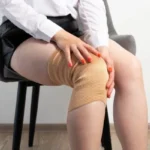If you suffer from bursitis, which causes swelling in the knee joint and pain when bending or extending your leg, you may be looking for ways to relieve your symptoms. One of the most effective treatments for bursitis is taping your knee. Read on to learn how to tape knee for bursitis.
To tape your knee for bursitis, start with a pre-wrap, apply athletic tape in an “X” pattern over the affected area, and secure it. This helps reduce inflammation and provide support. Consult a professional for proper taping techniques.
Types of Tape Used for Knee Bursitis
Bursitis is an inflammation of the bursa, a small sac of fluid that sits between bones and muscles, ligaments, and tendons. It can cause pain, swelling, and stiffness in the knee joint.
Fortunately, taping techniques have been developed to help alleviate some of the discomfort associated with bursitis in the knee. Let’s look at what types of tape are used for knee bursitis.
Kinesiology Tape
Kinesiology tape (often shortened to k-tape) is made from a porous cotton material designed to move with your body. The tape’s adhesive backing helps it stay securely in place while allowing a full range of motion in the knee joint.
In addition, the tape works by providing support and compression to reduce swelling around the affected area while simultaneously enabling free movement of the affected knee joint.
Also Read: Can You Use a Massage Gun After Knee Replacement?
Athletic Tape
Athletic tape is another popular option for helping with knee bursitis relief. This type of tape is often referred to as “rigid” or “stabilizing” because it has less stretch than other tapes on the market. It’s also known for its strong adhesive qualities, which help keep it securely in place even during vigorous activity.
Athletic tape provides more direct support than k-tape but may be less comfortable if you need constant support due to its rigid nature.
Gymnastics Tape
Gymnastics tape differs from athletic or kinesiology tapes because it has a more robust adhesive quality and can be applied directly over the skin without pre-taping preparations such as rubbing alcohol or skin creams.
It also offers more cushioning than athletic or kinesiology tapes. In addition, it provides extra protection against external pressure on the joints, like kneeling on hard surfaces during sports activities or exercise routines.
Also Read: Does Climbing Stairs Cause Knee Problems?
How To Tape Knee For Bursitis | Step By Step Procedure

Materials Needed
Before you begin taping, ensure you have all the necessary materials. You’ll need the following:
1. Kinesiology tape (elastic adhesive bandage)
2. Scissors
3. Pre-wrap material (non-adhesive foam)
4. Rubbing alcohol or antiseptic wipes
Preparation
Washing your skin before taping will help ensure that the adhesive sticks appropriately and doesn’t irritate. Clean the area with rubbing alcohol or antiseptic wipes before beginning. Once the skin is clean and dry, taping is time.
Application
Begin by wrapping pre-wrap around the affected area. This will help protect your skin from the tape and allow it to move more freely while providing support to the knee joint. Start at the top of the thigh and wrap downward, making sure not to cover up any symptoms or bruises on your leg.
Once finished with this step, start applying kinesiology tape in a figure 8 pattern starting at the bottom of your thigh and going around both sides of your knee joint (see diagram). Make sure that each piece of tape overlaps slightly with its predecessor, so there are no gaps between them.
It’s important not to stretch the tape too tightly, as this can cause discomfort rather than relief. Continue until you have reached an acceptable amount of coverage for yourself; typically, two strips should be enough, but it’s ultimately up to you!
Maintenance
Kinesiology tape should last anywhere from 3-5 days, depending on how much movement is involved in daily activities such as walking or running.
During this time, it’s essential to keep an eye on any skin color/condition changes and general comfort levels about pain management; if either worsens, remove the tape immediately and contact a medical professional if needed.
Additionally, make sure to re-apply a fresh layer of pre-wrap each day before putting new pieces of kinesiology tape over them so that everything stays secure throughout use!
Also Read: Can You Use Massage Gun on Knee?
Bottom Line:
So, now you know how to tape knee for bursitis. Taping can be an effective treatment for bursitis when done correctly and consistently maintained during use. Before beginning, ensure you have all materials gathered beforehand, and always cleanse your skin prior to application!
Be patient—it may take some trial and error before finding what works best for you—but with diligence, taping can go a long way towards relieving pain associated with bursitis in no time at all! Good luck!



